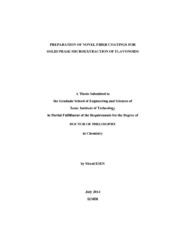Please use this identifier to cite or link to this item:
https://hdl.handle.net/11147/4255Full metadata record
| DC Field | Value | Language |
|---|---|---|
| dc.contributor.advisor | Eroğlu, Ahmet Emin | - |
| dc.contributor.author | Esen, Meral | - |
| dc.date.accessioned | 2014-12-08T09:50:51Z | - |
| dc.date.available | 2014-12-08T09:50:51Z | - |
| dc.date.issued | 2014-07 | - |
| dc.identifier.uri | http://hdl.handle.net/11147/4255 | - |
| dc.description | Thesis (Doctoral)--İzmir Institute of Technology, Chemistry, İzmir, 2014 | en_US |
| dc.description | Includes bibliographical references (leaves: 113-118) | en_US |
| dc.description | Text in English; Abstract: Turkish and English | en_US |
| dc.description | Full text release delayed at author's request until 2017.08.21 | en_US |
| dc.description.abstract | Many plant species contain flavonoids which are widely utilized in food, pharmaceutical and cosmetics industries as additives. Literature studies show that most of the earliest drugs were of plant origin. Application of flavonoids in many fields necessitates the development of new extraction and determination methods in various samples. In this study, three different types of solid phase microextraction (SPME) coatings were produced. The first one is baicalin- and imidazole-functionalized silica fibers via sol-gel method. Both manual and dip-coating were employed. The fibers were examined by SEM and the results show that dip-coating produced more homogeneous coatings. The second one is polystyrene templated monolithic silica. Then, it was functionalized with baicalin and imidazole groups. The last solid phase microextraction coating is molecularly imprinted silica. In this case, a sol-gel process was used to synthesize molecularly imprinted silica with tetraethoxysilane (TEOS) as the crosslinking agent, aminopropytriethoxysilane (APTES) as a functional monomer, quercetin as the template molecule, and AlCl3 as a Lewis acid. Characterization of baicalin-functionalized monolithic silica and molecularly imprinted silica was achieved by SEM, FTIR, TGA and elemental analysis. SPME process was followed by HPLCDAD at 335 nm after separation of flavonoids on a Zorbax Eclipse XDB-C18 (5μm, 4.6x150mm) column at 25.0°C with gradient elution using methanol and water (containing 0.10% acetic acid). Functionalized silica fibers were utilized in solid phase microextraction of apigenin, apigetrin, eriodictyol, isoquercitrin, luteolin, and quercetin. The results demonstrated that higher extraction efficiency can be obtained with baicalinfunctionalized monolithic silica and molecularly imprinted silica coated fibers. | en_US |
| dc.language.iso | en | en_US |
| dc.publisher | Izmir Institute of Technology | en_US |
| dc.rights | info:eu-repo/semantics/openAccess | en_US |
| dc.subject | Solid phase microextraction | en_US |
| dc.subject.lcsh | Flavonoids | en_US |
| dc.title | Preparation of novel fiber coatings for solid phase microextraction of flavonoids | en_US |
| dc.title.alternative | Flavonoidlerin katı faz mikroekstraksiyonu için yeni fiber kaplamalarının hazırlanması | en_US |
| dc.type | Doctoral Thesis | en_US |
| dc.department | Thesis (Doctoral)--İzmir Institute of Technology, Chemistry | en_US |
| dc.relation.publicationcategory | Tez | en_US |
| item.fulltext | With Fulltext | - |
| item.openairecristype | http://purl.org/coar/resource_type/c_18cf | - |
| item.languageiso639-1 | en | - |
| item.grantfulltext | open | - |
| item.openairetype | Doctoral Thesis | - |
| item.cerifentitytype | Publications | - |
| Appears in Collections: | Phd Degree / Doktora | |
Files in This Item:
| File | Description | Size | Format | |
|---|---|---|---|---|
| 10013398.pdf | DoctoralThesis | 7.32 MB | Adobe PDF |  View/Open |
CORE Recommender
Page view(s)
230
checked on Nov 25, 2024
Download(s)
182
checked on Nov 25, 2024
Google ScholarTM
Check
Items in GCRIS Repository are protected by copyright, with all rights reserved, unless otherwise indicated.